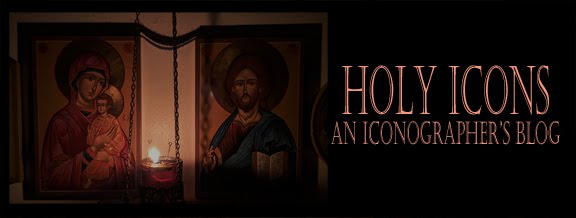Meandering down the aisles of the local Costco with my dad and my three children yesterday, I caught the attention of one little girl. She and her parents were going in the opposite direction we were, and so every aisle, we would encounter her again, and every time, she would ask her parents why I was wearing a dress. Not wanting to intrude on their shopping trip, I simply smiled to myself at the question.
It's a good question that I even ask myself sometimes. Setting aside the historical development of clerical garb, why do I wear a dress? I know there are many clergy who don't wear a cassock when they go out on anything but church business. I have no interest in arguing whether they are right or wrong in doing so. But I almost always wear my cassock and cross outside the house, and my reasons have little to do with whether it is right or wrong to do so.
One might think that I do it because I like to draw attention to myself. As an extreme introvert, I can tell you that is definitely not the reason. Every time that someone looks me up and down trying to figure out why I might be wearing such a ridiculous get-up, I feel like shrinking down into a crack in the floor and running away. If I did it because I "love greetings in the marketplace and being called Rabbi, Rabbi" I wouldn't be getting what I was after anyway.
I dress this way because sometimes people will ask for prayers, sometimes people want to talk, or they want to know something about my church. It's a chance for serving others. I recently had an encounter on the streets of Brooklyn. I was walking from a friend's house to the place where I was staying and a man was intrigued by my outfit and asked me what it meant. We talked as we walked along about why I became a priest. He was a special education teacher, a job which is also a vocation that depends on love and service. He described himself as a rabid atheist, but we still had a nice conversation that unfortunately ended too soon. Dressing this way is a reminder that there are still people who believe, still people who pray, still people who will listen -- not all of them dress the way I do, but I can remind people, or rather my clothing can remind people, that they are there.
I would be lying if I said that this is why I walk down the aisles of Costco in a dress, however. I do it because I am a prodigal. Every year when I read the gospel on the Sunday of the Prodigal Son, I am struck by the things the father gives his son upon his return. Since my own return from a far off land, I too have been given a robe, a ring, and shoes on my feet. In my prodigal times I was not only away from the Church, but also very lonely. Since returning, since committing to live as a hired servant, God has blessed me with a wonderful wife. My wedding ring is a reminder of my return as are the shoes on my feet (my wife has always insisted on me wearing better shoes than I would normally buy myself). The robes I have been given to wear as a priest are a constant reminder me of how far I departed, how miserable that life was, and how much forgiveness I have received.
If I'm honest with myself, I'm a little afraid that if I take off my robe I will be found without a festal robe at the wedding banquet. I need that reminder every day of the great gift I have been given. I need the stares and occasional derision to remind me that I don't belong to this world and that I need to live for the Kingdom which is to come. I am glad when it gives me the opportunity to share something about my faith with others, or to serve as a reminder that the Church still exists, because we are all prodigals who need to remember our father's house, who need to be reminded that we need not be in want when His hired servants have it better, and to be prompted to return home and find forgiveness.
That, for my little friend at the Costco, is why that man was wearing a dress.
Be Prepared Book Review
-
Be Prepared is a wonderful autobiographical comic about the author's
experience of being culturally different from other children and the trials
of mak...
1 month ago











